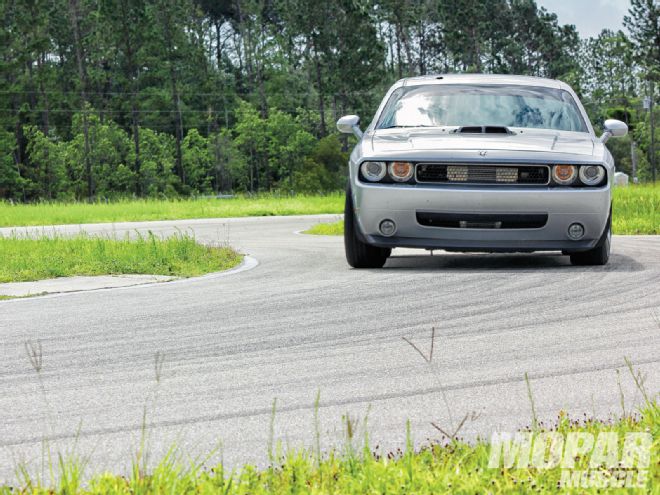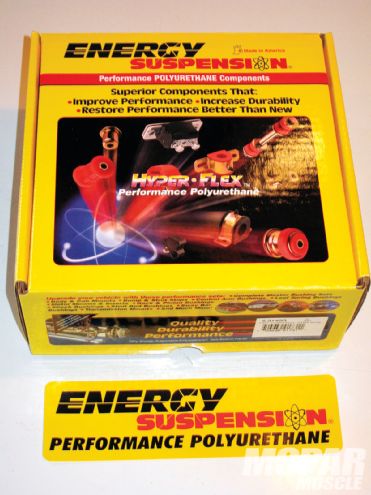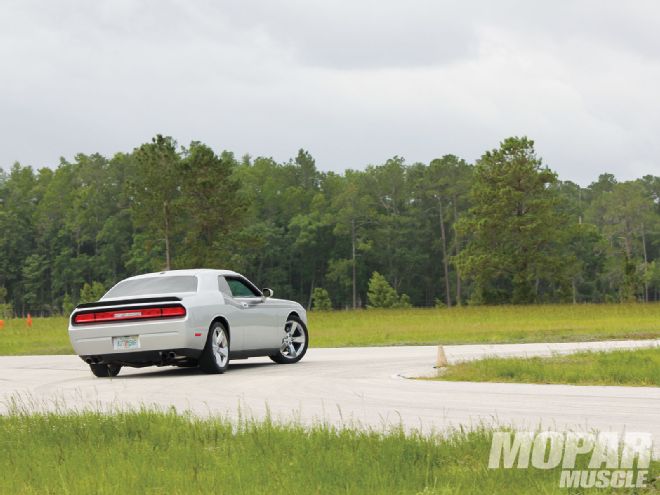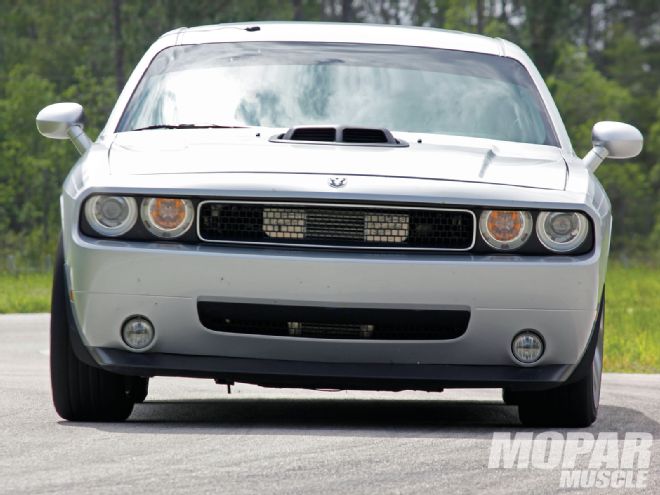
We enjoy driving our 2009 Dodge Challenger, as it is arguably one of the most well-rounded vehicles ever produced by the Chrysler Corporation. With Hemi power, great braking, and independent rear suspension the new Challenger does everything well, but of course we wanted our R/T model to perform better than it does in stock form. To enhance our car's performance, we've already installed a ProCharger supercharger and aftermarket exhaust, as well as Wilwood disc brakes with six-piston front calipers, four-piston rear calipers, and large diameter rotors to get our Challenger stopping in shorter distances. To improve our car's handling, we installed Eibach front and rear sport suspension featuring larger diameter sway bars, re-valved shocks, and stiffer front and rear coil springs with a lowered ride height. We also installed a bumpsteer kit from Razor's Edge Motorsports. There's one area of the suspension found in late model Mopars, the factory rubber bushings, that limits how well these cars handle, so we decided to replace the stock suspension bushings in our Challenger for enhanced handling performance.
When any car is manufactured, there are always compromises in terms of performance, ride quality, and costs. The suspension of the new Chrysler products is no exception, as they install the best components they can, to offer good handling and ride, while still being able to sell the car at a competitive price. We've already replaced some of our Challenger's suspension components like the shocks, springs, and sway bars, and have enjoyed better handling and braking thanks to these changes, but to eliminate the flex and body roll that the rubber bushings allow, we felt that they had to go. Every car, including our Challenger, has rubber components in the suspension, which are intended to isolate the individual components from the rest of the car, preventing vibrations from disturbing the car's occupants. The Challenger, as well as the new Chargers and 300s, use rubber bushings throughout the front and rear suspension, even where the rear suspension cradle is attached to the car's subframe.
 1. Energy Suspension has more than 20 years experience manufacturing polyurethane suspension components for Mopar vehicles, and now their Hyper-Flex line is available for late-model cars like our 2009 Dodge Challenger. The Hyper-Flex bushings won't flex like factory suspension bushings, and are impervious to oils, chemicals, and road salts that can damage rubber components.
1. Energy Suspension has more than 20 years experience manufacturing polyurethane suspension components for Mopar vehicles, and now their Hyper-Flex line is available for late-model cars like our 2009 Dodge Challenger. The Hyper-Flex bushings won't flex like factory suspension bushings, and are impervious to oils, chemicals, and road salts that can damage rubber components.
The problem with rubber bushings is that, while they do a good job of insulating the car from road noise and vibrations, they also allow a considerable amount of suspension flex, which is counterproductive to good handling, acceleration, and braking. There are rubber bushings throughout the late model Challenger, both in the front and rear control arms, trailing arms, and shock mounts, and the combined affect that these bushings can have during aggressive driving is substantial. Rubber bushings allow a great amount of flex, especially when the car is cornering, and can prevent the tires from making maximum contact with the pavement as well as altering the alignment of the front and rear wheels. In the front, this issue is amplified by the rubber bushings holding the rack and pinion in place, and in the back, the entire independent rear suspension cradle is held in place by rubber bushings.
For maximum performance, the factory suspension bushings should be replaced with components that flex less than rubber. In all-out racing applications, certain bushings are replaced with solid components, but in street cars or street/strip applications, the bushings still need to isolate the vibrations from the car's cabin. Energy Suspension is known for their line of high-performance suspension components for classic Mopars, and now offers polyurethane front and rear suspension parts for late model Dodge and Chrysler products.
 2. We wanted to quantify the difference these suspension components would make, so we took our Challenger to Auto-plus raceway in gainesville, Florida, to establish a baseline. On the road course, our Challenger turned lap times of 1:16.5 and 1:16.6 seconds with the factory rubber suspension bushings installed.
2. We wanted to quantify the difference these suspension components would make, so we took our Challenger to Auto-plus raceway in gainesville, Florida, to establish a baseline. On the road course, our Challenger turned lap times of 1:16.5 and 1:16.6 seconds with the factory rubber suspension bushings installed.
Polyurethane is an advanced product that flexes far less than rubber, but still allows a certain amount of isolation between the car's chassis components and the car itself. Energy Suspension has more than twenty years of experience with polyurethane, and their Hyper-Flex performance polyurethane is a proprietary, technically advanced formula that has earned them nine U.S. patents. Unlike rubber, Hyper-Flex performance polyurethane components don't compress from weight or road forces, and won't rot or deteriorate due to exposure to oil, chemicals, or road salt. Hyper-Flex components are a free-floating, non-binding design, and Energy Suspension track tests all of their products before bringing them to market. The Energy Suspension Hyper-Flex components are available in red or black, both offering the same basic chemical polyurethane formula, with graphite added to some of the black bushings for additional lubrication. For our Challenger, we chose a full set of front and rear bushings in red, and decided to test our car on the track to determine how much of a difference these bushings make. To establish a performance baseline for our Challenger, we took the car to Auto-Plus Raceway in Gainesville, Florida, for some timed laps around their road course. With the factory rubber bushings in our Challenger's suspension, our car turned lap times of 1:16.6 and 1:16.5 on its best two laps. With our baseline established, we took the car to Inline Performance Specialists in nearby Bushnell, Florida, to install our Energy Suspension Hyper-Flex polyurethane bushings.
Polyurethane is an advanced product that flexes far less than rubber, but still allows a certain amount of isolation between the car's chassis components and the car itself. Energy Suspension has more than twenty years of experience with polyurethane, and their Hyper-Flex performance polyurethane is a proprietary, technically advanced formula that has earned them nine U.S. patents. Unlike rubber, Hyper-Flex performance polyurethane components don't compress from weight or road forces, and won't rot or deteriorate due to exposure to oil, chemicals, or road salt. Hyper-Flex components are a free-floating, non-binding design, and Energy Suspension track tests all of their products before bringing them to market. The Energy Suspension Hyper-Flex components are available in red or black, both offering the same basic chemical polyurethane formula, with graphite added to some of the black bushings for additional lubrication. For our Challenger, we chose a full set of front and rear bushings in red, and decided to test our car on the track to determine how much of a difference these bushings make. To establish a performance baseline for our Challenger, we took the car to Auto-Plus Raceway in Gainesville, Florida, for some timed laps around their road course. With the factory rubber bushings in our Challenger's suspension, our car turned lap times of 1:16.6 and 1:16.5 on its best two laps. With our baseline established, we took the car to Inline Performance Specialists in nearby Bushnell, Florida, to install our Energy Suspension Hyper-Flex polyurethane bushings.
Installing new suspension bushings in a late model Mopar is fairly straight forward, and requires basic tools found in most automotive shops. Inline Performance specializes in Mopar vehicles, so they quickly got busy removing the factory rubber bushings to replace them with the new polyurethane units. Up front the control arms and various components can be removed individually, the rubber bushings removed, and the Hyper-Flex bushings installed before reinstalling each component. In addition to the control arm bushings, we also installed Hyper-Flex bushings in the rack and pinion mount locations, and the shock mounts.
Since the rear suspension of the Challenger is encompassed in a cradle that is held to the car's subframe with four bolts, it's easiest to remove the drive shaft and calipers, then drop the entire rear IRS “unit” from the car to perform the suspension work. With the rear suspension and cradle on the shop floor, it's easy to access all of the suspension components, and again the rubber bushings can be removed and the Hyper-Flex polyurethane bushings installed in their place. All told, we had the front and rear bushings replaced in a day's work, and checked the car's wheel alignment to make sure it was still within the factory specifications.
On the way back to Auto-Plus Raceway to re-test our Challenger's handling, we noticed that our car definitely felt more connected to the road. Ride quality was somewhat stiffer, but still comfortable, and the car definitely took the corners flatter, without the body roll associated with the flexible rubber bushings. On the road course at Auto-Plus Raceway, we made a couple of warm up laps and then made two back to back test laps. The car felt quicker around the course not just through the corners, but when accelerating off of the corners as well. On stock tires, our lap times during our test laps dropped to 1:14.1 seconds for each of the two laps. This is a reduction of more than two seconds from our baseline laps, a clear indication that the Energy Suspension Hyper-Flex performance polyurethane bushings made a dramatic difference in our car's handling.
Here at Mopar Muscle there are times when we test products and don't see the results we expect. During this test, however, it was clear that the Energy Suspension products made a big difference that we not only felt in the seat of our pants, but saw in reduced lap times on the road course. The improvements we saw were on the stock tires that our Challenger came with from the factory, and we feel that stickier compound tires would really benefit our car now that the chassis and suspension have less flex. If you have a late-model Mopar, we encourage you to visit Energy Suspension's website and check out the Hyper-Flex components they make for your car, we can say from our testing and experience that these products do make a difference.
Part Cost Rear sub-frame bushings $195.99 Rear control arm bushings $101.38 Rear differential bushings $48.99 Rear lower shock mount bushings $71.99 Rear sway bar and end link bushings $29.99 Rear trailing arm front bushings $31.41 Rear trailing arm rear bushings $41.41 Front control arm bushings $135.95 Front lower shock mount bushings $71.99 Front sway bar bushings $13.99 Rack and pinion bushings $23.99
Lap Times - Stock
 10. Driving to the track, we could tell that our Challenger was more connected to the road, and had a slightly stiffer ride though ride quality was still good. On the track, we made a couple of warm up laps before putting our foot into it to
get some real test times. We ran two laps back to back, resulting in identical lap times of 1:14.1 seconds. With the Energy Suspension bushings our Challenger was noticeably quicker through the turns, and stayed hooked up better when we accelerated out of the corners. Dropping some 2.5 seconds from our lap times around the road course, we can say with certainty that Hyper-Flex performance polyurethane bushings dramatically improved the performance of our late-model Challenger.
10. Driving to the track, we could tell that our Challenger was more connected to the road, and had a slightly stiffer ride though ride quality was still good. On the track, we made a couple of warm up laps before putting our foot into it to
get some real test times. We ran two laps back to back, resulting in identical lap times of 1:14.1 seconds. With the Energy Suspension bushings our Challenger was noticeably quicker through the turns, and stayed hooked up better when we accelerated out of the corners. Dropping some 2.5 seconds from our lap times around the road course, we can say with certainty that Hyper-Flex performance polyurethane bushings dramatically improved the performance of our late-model Challenger.